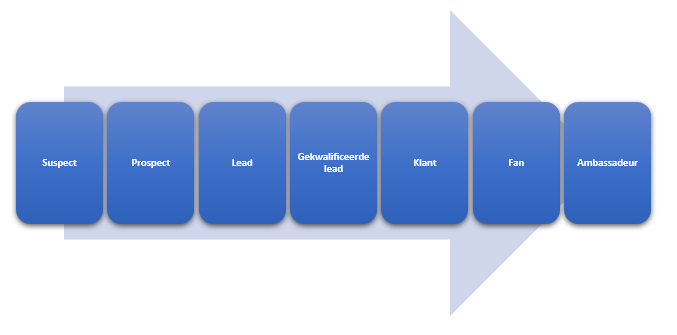Summary
Discover how to improve the marketing and sales process by viewing it as a production process. This article discusses the process in detail and covers important aspects such as customer acquisition, marketing at the orientation stage and the collaboration between sales and marketing. Learn how to get a grip on your commercial activities and discover the different stages of the purchase decision process. Calculate the cost of acquiring new customers and determine the return on your marketing efforts. Improve your sales process and gain insight into where you can grow and improve.
Content:
- Where sales and marketing complement each other
- The purchase decision process
- What does a new customer cost?
- What is the return on your marketing?
- Are you recouping your selling expenses?
Current process
Whereas acquiring new clients was mostly seen as a hunting process in the old economy, in the 21st century it is time to think about client acquisition as a production process. With the increasing availability of information, buyers are becoming increasingly precise at their beck and call. When selecting new suppliers, your potential customers’ internal decision-making process is becoming longer and the orientation phase more important.
The salesperson is not the appropriate person to engage in that orientation phase. Your marketing efforts will have to provide the building blocks for your potential customer’s decision-making process at that stage. In this article, I’ll take you through the commercial process and outline how you can make sense of it for your own business. All this so that you can get a grip on your commerce.
Where sales and marketing complement each other
The consequence of the extended acquisition process is that corporate sellers often enter the picture too early. Salespeople are valuable, expensive forces, who do best when the relationship with the customer is established. Read here How to get a better grip on your sales process. They no longer make a valuable contribution to the inventory phase, as they used to, because information about your product or service is widely available. It leads to a new challenge because it creates a space between marketing efforts and sales in which you risk being out of touch with your prospect.
I saw a good example of this recently with a relationship within the health and safety service industry. The company had a lot of trouble converting the leads that came in to orders. Further investigation revealed that the information provided by the company to the customer in the orientation phase was greatly appreciated, but more importantly led prospects to orient themselves more broadly and ultimately give the final order to a colleague in 80% (!) of cases.

That space between marketing and sales is filled by tools that measure whether your value proposition matches the needs of your suspects. Only when it is determined that the prospect is at the end of its orientation phase does it receive lead status within that process. This saves a lot of sales costs at a stage when no sale is going to happen yet. It is quite possible to get the buzz around your product or service right. Through the use of
(automated) marketing
put your salespeople in a position to confirm and perpetuate the relationship with the new customer. Before we go further into what ways you can make the process more efficient, it is important to know what this process looks like.
How do you make your marketing and sales work better together?
Read it in the white paper: Account Based Marketing, learn how to make sales and marketing work together!
The purchase decision process
The purchase decision process (or commercial process) consists of seven stages. The stages differ in degree of involvement and information needs. To create insight into the return on investment, it is important to understand this process. Suppose your company has a high conversion rate from qualified lead to customer but few customers move on to ambassador. This means you have good salespeople, but probably need to work on account management.
The same can be done at the beginning of the process. Maybe you have a lot of prospects but your calendar is empty. This means that you have a story that many people are somewhat interested in but you are not convincing enough to actually make that appointment.
In this process, 3 business areas are important. The first 3 phases fall under marketing, phases 4-5 under sales and phases 6-7 under account management. So it is important to remember that when we talk about commerce we mean the entirety of activities that fall under marketing, sales and account management.
Below we provide the definition, level of involvement and information needs for each phase.

Suspect (marketing)
A suspect is someone with a latent need (i.e. someone who does not yet have a problem but may start having one). Because a suspect does not yet have a concrete need it is important to give these people general information about a problem so that a need for a solution comes .
Information need: because they have no concrete need, there is also no immediate need for information. The important thing is to make them aware of the potential problem.
Degree of involvement: low
Prospect (marketing)
A prospect is someone with a concrete need/problem. To get a clear picture of all the solutions, they search online for general information.
Information needs: general information about their problem. Prospects are getting a picture of all possible solutions and exploring the market. Corporate websites, blogs and social media are used for this purpose.
Degree of involvement: low/moderate
How do you make your marketing and sales work better together?
Read it in the white paper: Account Based Marketing, learn how to make sales and marketing work together!
Lead (marketing)
A lead is someone who has a general idea of all the solutions to the problem, has chosen 2 or 3 solutions and is looking for more in-depth information about them.
Information needs: in-depth information via webinars, white papers, tutorials and e-books.
Degree of involvement: moderate

Qualified lead (sales)
A qualified lead is someone who has all the information about the solutions and needs to choose from them. In this phase, you put sales in position to convince the person to choose you.
Information needs: information from budgets such as what to expect, how long it will take and price.
Degree of involvement: moderate/high
Customer (sales)
A customer is anyone who purchases something from you. To pull a customer through to fan, it is important to do expectation management. By doing a little more than they expect, they become so satisfied that they stay long-term.
Information needs: it is important to keep them informed about the project. If there are little things you can do extra you should do it and communicate that you are doing it.
Degree of commitment: high
Fan (account management)
A fan is a repeat/long-term customer.
Information needs: constant communication is needed with fans. Trends in your field that affect customers are important to share. An account plan (in which you describe all the future projects you can do with that client) is also very important.
Degree of involvement: high/extreme
Ambassador (account management)
An ambassador is a customer who is so satisfied that they actively promote your company in the marketplace. These are often long-term customers who, based on a good history, know what your company can do.
Information needs: with ambassadors, it is important that you keep them informed. Of events, trends and news so they can use this again when talking to people.
Degree of involvement: extreme
What does a new customer cost?
Now that we know what the process looks like, it’s time to understand this. Only a quarter of Dutch b2b companies know how much it costs to acquire a new customer. Read
here
more about the six steps to new customers. This while companies invest more money on sales than on other things, easily about 15% of their revenue. So it is important to know how much you are spending on sales and marketing and what your return on investment is.
There are two types of costs you incur, marketing and sales. Most of the cost in sales is the hours. In addition, you have the support items such as a company car, laptop or phone or travel expenses. This is infrastructure needed to get a vendor into position. In marketing, too, most of the costs are in the hours. In addition, you have direct costs from your marketing channels.
The simplest way to calculate what a new customer costs is to add up all costs and divide by the number of new customers. So these are:
- All personnel costs of salespeople and marketers.
- All direct costs for your marketing and sales channels, this includes all costs for your website (such as hosting), business or entrepreneurial clubs, trade shows, sponsorships and advertising.
- All costs for infrastructure such as cars, laptops and software such as CRM or marketing automation.
This way you know what a new customer costs. However, you don’t know where in the process the areas for improvement are and what works or doesn’t work. This is important information to optimize the process. Therefore, in the following I will go into more detail on how to properly calculate these costs.
How do you make your marketing and sales work better together?
Read it in the white paper: Account Based Marketing, learn how to make sales and marketing work together!
What is the return on your marketing?
To calculate the effectiveness of your marketing channels or resources, we need to know a few things. First, it is important to determine what your goal is with a particular channel or resource. We identify three:
- Creating awareness: coming to the attention of as many people as possible
- Generating leads: collecting (contact) data and identifying interests
- Direct revenue: making money directly
Once you have stated what goal you want to achieve per channel you fill in what the return on investment is.
In addition, you want to know how much the channel or resource costs. There are two types of costs: direct costs and hourly costs. Direct costs include things like outside copywriters, tooling to use specific channels or resources such as mailing software or an advertising agency developing a campaign for you. Many channels have no direct cost, for example, social media. If you don’t advertise you (often) have no direct cost but it does take time and time is money.
Once you have entered the above variables for all the channels you use, you will get an overview for each goal. In this overview, you can see how much the channels cost per unit, either:
- How much does it cost to reach one person
- How much does a lead cost
- How much does one euro of revenue cost

Marketing channels and content
There are channels you use to increase your brand awareness. Traditional advertising on radio, television or in newspapers or magazines is something companies do primarily to increase brand awareness. Social media is also often used to reach as many people as possible. And an important reason to blog is to get visitors to your website. Read here the blogging for dummies. Calculate the cost per person reached:
- Social media: calculate how many hours you put in, multiply it by your hourly wage and divide it by the number of people you reached in total.
- Advertising on traditional media: calculate how many hours you put in, multiply this by your hourly wage, add to this the direct advertising costs and divide this by the number of people you reached in total.
- Blogging (SEO): calculate how many hours you put into it, multiply by your hourly wage and divide by the number.
Other channels you use to bring in leads directly. Often these are channels with direct costs such as online advertising or trade shows. Because this is a direct investment, you want to have a more quantifiable goal than awareness. When you advertise online and link to a white paper or newsletter subscription, you measure how many people actually leave data. At business clubs and trade shows, one unit of measurement is how many business cards you collect. Calculate cost per lead: direct costs plus hours times hourly wage divided by number of leads
- Online advertising (Google AdWords or on social media):
- Business clubs
- Scholarships
Sometimes you want to sell something directly online. Within B2B, this often comes down to workshops, publications or low-end products. This is what you can use online advertising for. This objective involves adding up all the direct costs you incur for this plus again the number of hours you put in times hourly wages. You divide this number by the direct total revenue of what was sold. So you calculate how many euros you need to invest to earn one euro.
- Workshops/webinar
- Books
How do you make your marketing and sales work better together?
Read it in the white paper: Account Based Marketing, learn how to make sales and marketing work together!
Are you recouping your selling expenses?
The B2B market often has to rely on (personal) sales. On average, a salesperson spends 20 percent of his time selling. If within a company the entrepreneur does the selling, this is even less. Therefore, it is important to calculate what your return on sales is. For this calculation, we leave out marketing costs because we are only talking about the effectiveness of sales, we assume cold acquisition for convenience. If you use marketing to collect the first stages suspect & prospect and move the leads on to sales from lead you can complete the calculation from the “appointment stage. To calculate return on sales, you need to know your average customer value and average cost of sales.
Average customer value
Every customer contributes to revenue. To make a good comparison, it is wise to work with an average customer value. This is the company’s total sales over a one-year period divided by the number of customers. If you multiply this by the average number of years the customers purchase then you have the average customer value.
Average customer value = (Revenue year Y / number of customers) * average number of years of customer.
Average cost of sales
Sales is an active process that often looks like this: you need a number of touch points before you have an appointment. This could be over the phone, by email, over drinks or, of course, on LinkedIn. The second step in the sales process is the appointment itself. From this comes (often) a quote/bid and the process ends, of course, with an order. In a perfect world, you need 1 contact moment for an appointment, 1 appointment for a quote/offer, and every quote/offer becomes an order. When this situation occurs, the average sales cost per new customer is about 260 euros. I explain below how we calculate this.
Average cost of sales =
(number of contact moments / 5 average per hour) * hourly rate + (4 hours per appointment * hourly rate) * number of appointments + (2 hours busy per quote * hourly rate) * number of quotes to order

How do you calculate the average sales cost per job?
How much does an hour cost?
In our calculation, we assume a salesperson’s hourly rate. A salesperson costs an average of 50 euros per hour. This includes all costs besides the hourly wage, such as travel expenses, vacation pay and all hardware from business (car, laptop and phone). If you do not employ a vendor, you can enter your own costs here.
Contact moments to an appointment
A nimble commercial employee gets to an average of 5 quality calls per hour. If you need one contact moment for an appointment, making an appointment costs 10 euros.
Number of appointments
Here you enter from how many appointments one quote comes from. An appointment takes an average of four hours. This is the time you spend on the appointment itself, as well as travel time, pre-work and administration.
Quote/offer
It varies by type of business how long you spend on a quote. When you provide standardized products or services, you spend less time on a quotation than when you provide complex products or services. In addition, it is important to know how many quotes are converted into orders.
Example
In the example, we assume cold acquisition. Take as an example that you need 10 calls with 5 follow-up emails to make an appointment. The appointments are often by way of introduction, so you get 1 offer out of 5 appointments. Making a quote takes 2 hours and from 2 quotes comes an order. Your average cost of sales is then:
(15 contact moments / 5 average per hour) * 50 euros per hour + (4 hours per appointment * 50 euros per hour) * 5 appointments + (2 hours busy per quote * 50 euros per hour) * 2 quotes to order = 1,350 euros per new customer
So, in the ideal situation, you have:
(1 contact moments / 5 average per hour) * 50 euros per hour + (4 hours per appointment * 50 euros per hour) * 1 appointments + (2 hours busy per quotation * 50 euros per hour) * 1 quotations to order = 260 euros per new customer
Next
Now that you have the average sales cost per new customer divide it by the average customer value you have and multiply this number by 100. This is the percentage you spend on average on sales per new customer.
How do you make your marketing and sales work better together?
Read it in the white paper: Account Based Marketing, learn how to make sales and marketing work together!
In conclusion
As a result of this article, I hope you know the difference between marketing and sales and have gained a better understanding of your own commercial process. It is wise to once put all your relationships on the measuring stick of the purchase decision process. When you track this every year you start to see where you are good at and where you can improve. I also recommend concretizing the return on your marketing and sales so you can make weighted decisions in your commercial plans. After all, you know which channels yield the most return and what works or doesn’t work. In addition, you also know what you can improve on in the sales process. If you have many appointments but few offers, then either the appointments are at too early a stage (are still prospects and not leads) or something goes wrong in the conversation.

By seeing your commercial process as a production process, you can save money, get higher returns, and all of this also ultimately leads to happy employees doing what they do best.




